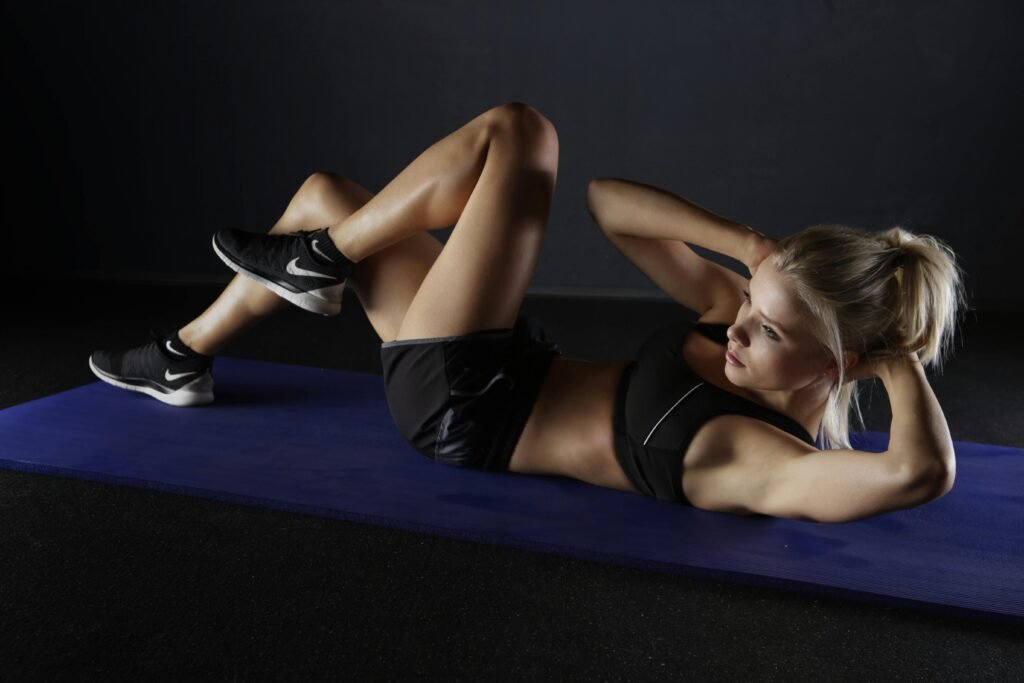Table of Contents
The Importance of Exercise

Brief Overview of the Benefits of Regular Physical Activity
Regular physical activity is a cornerstone of a healthy lifestyle. Engaging in consistent exercise offers a multitude of benefits that extend beyond physical health. Here are some key advantages:
- Improved Cardiovascular Health: Exercise strengthens the heart and improves circulation, reducing the risk of heart disease and stroke.
- Weight Management: Regular physical activity helps maintain a healthy weight by burning calories and increasing metabolism.
- Enhanced Mental Health: Exercise releases endorphins, which are natural mood lifters. It can reduce symptoms of depression, anxiety, and stress.
- Stronger Muscles and Bones: Weight-bearing exercises, such as walking and strength training, increase bone density and muscle strength, reducing the risk of osteoporosis.
- Better Sleep: Regular exercise can help you fall asleep faster and enjoy deeper sleep.
- Increased Longevity: Studies show that regular physical activity can add years to your life by reducing the risk of chronic diseases.
- Boosted Immune System: Moderate exercise can enhance immune function, helping the body fight off infections.
Statistics on Physical Inactivity and Its Health Consequences
Despite the well-documented benefits of exercise, physical inactivity remains a significant public health issue. Here are some alarming statistics and their associated health consequences:
- Global Inactivity Rates: According to the World Health Organization (WHO), approximately 1 in 4 adults globally is not active enough.
- Health Risks: Physical inactivity is a leading risk factor for non-communicable diseases such as cardiovascular diseases, cancer, and diabetes. It is estimated to cause 9% of premature mortality worldwide.
- Economic Impact: The economic burden of physical inactivity is substantial. In the United States alone, it is estimated to cost $117 billion annually in healthcare expenses and lost productivity.
- Obesity Epidemic: Sedentary lifestyles contribute significantly to the obesity epidemic. In the USA, over 42% of adults are classified as obese, which increases the risk of numerous health conditions, including type 2 diabetes and heart disease.
- Mental Health: Lack of physical activity is linked to higher rates of depression and anxiety. Regular exercise is a proven method to improve mental health and well-being.
By understanding the profound benefits of regular physical activity and the severe consequences of inactivity, individuals can make informed decisions to incorporate more movement into their daily lives. Encouraging a culture of exercise can lead to healthier, happier communities.
General Exercise Guidelines

Recommendations from the WHO and CDC
Both the World Health Organization (WHO) and the Centers for Disease Control and Prevention (CDC) provide clear guidelines to help individuals achieve optimal health through regular physical activity. These recommendations are designed to be flexible and adaptable to various lifestyles and fitness levels.
- WHO Guidelines: The WHO recommends that adults aged 18-64 should engage in at least 150-300 minutes of moderate-intensity aerobic physical activity or at least 75-150 minutes of vigorous-intensity aerobic physical activity throughout the week. Additionally, muscle-strengthening activities should be done on two or more days a week.
- CDC Guidelines: The CDC echoes similar recommendations, emphasizing the importance of both aerobic and muscle-strengthening activities. They suggest that adults should aim for at least 150 minutes of moderate-intensity aerobic activity, such as brisk walking, or 75 minutes of vigorous-intensity activity, such as running, each week. Muscle-strengthening activities should also be included on two or more days a week.
Explanation of Moderate vs. Vigorous Exercise
Understanding the difference between moderate and vigorous exercise is crucial for tailoring your fitness routine to meet these guidelines.
- Moderate-Intensity Exercise: This level of exercise increases your heart rate and makes you breathe faster, but you should still be able to hold a conversation. Examples include brisk walking, dancing, gardening, and cycling on flat terrain.
- Vigorous-Intensity Exercise: This level of exercise significantly increases your heart rate and breathing. You will find it difficult to speak more than a few words without pausing for breath. Examples include running, swimming laps, aerobic dancing, and cycling uphill.
Weekly Exercise Targets
To meet the exercise guidelines set by the WHO and CDC, you can mix and match moderate and vigorous activities throughout the week. Here are some practical targets:
- Moderate Activity: Aim for 150-300 minutes per week. This could be 30-60 minutes of moderate exercise five days a week.
- Vigorous Activity: Aim for 75-150 minutes per week. This could be 25-50 minutes of vigorous exercise three days a week.
- Combination: You can combine both moderate and vigorous activities to meet your weekly targets. For example, you might do 30 minutes of moderate exercise on three days and 20 minutes of vigorous exercise on two days.
By following these guidelines, you can ensure that you are getting enough physical activity to maintain and improve your health. Remember, the key is consistency and finding activities that you enjoy, making it easier to stick with your exercise routine.
Tailoring Exercise to Your Age and Fitness Level
Exercise Recommendations for Different Age Groups
Children (5-17 years)
- Daily Activity: Children should engage in at least 60 minutes of moderate to vigorous physical activity daily.
- Types of Exercise: Activities should include aerobic exercises like running, swimming, and cycling. Muscle and bone-strengthening activities, such as jumping and climbing, should be incorporated at least three times a week.
- Benefits: Regular exercise helps in healthy growth and development, improves cardiovascular fitness, and supports mental health.
Adults (18-64 years)
- Weekly Activity: Adults should aim for 150-300 minutes of moderate-intensity aerobic activity or 75-150 minutes of vigorous-intensity activity each week.
- Types of Exercise: A mix of aerobic exercises (like brisk walking, running, and cycling) and muscle-strengthening activities (such as weight training and resistance exercises) on two or more days a week.
- Benefits: Regular exercise reduces the risk of chronic diseases, improves mental health, and enhances overall quality of life.
Seniors (65 years and older)
- Weekly Activity: Seniors should follow the same guidelines as adults, with a focus on activities that improve balance and prevent falls.
- Types of Exercise: Aerobic exercises (like walking and swimming), muscle-strengthening activities, and balance exercises (such as tai chi and yoga) are recommended.
- Benefits: Exercise helps maintain mobility, reduces the risk of falls, and improves cognitive function and mental health.
Adjusting Exercise Intensity and Duration Based on Fitness Levels
Beginners
- Start Slow: Begin with low-intensity activities like walking or gentle yoga. Gradually increase the duration and intensity as fitness improves.
- Short Sessions: Start with short sessions of 10-15 minutes and gradually build up to longer durations.
- Consistency: Focus on consistency rather than intensity. Aim to be active most days of the week.
Intermediate
- Increase Intensity: Incorporate moderate-intensity activities like brisk walking, cycling, or swimming. Include some vigorous activities like running or high-intensity interval training (HIIT) as fitness improves.
- Balanced Routine: Combine aerobic exercises with muscle-strengthening activities. Aim for at least 30 minutes of moderate activity on most days.
- Variety: Mix different types of exercises to keep the routine interesting and to work different muscle groups.
Advanced
- High Intensity: Engage in vigorous-intensity activities and advanced strength training. Include activities like running, competitive sports, or advanced HIIT workouts.
- Longer Sessions: Aim for longer exercise sessions, such as 45-60 minutes of vigorous activity, several times a week.
- Specific Goals: Tailor the exercise routine to specific fitness goals, such as training for a marathon or improving athletic performance.
By tailoring exercise routines to different age groups and fitness levels, individuals can maximize the benefits of physical activity while minimizing the risk of injury. It’s important to listen to your body and adjust the intensity and duration of exercise as needed to ensure a safe and effective workout regimen.
Types of Exercise

Aerobic Exercises: Walking, Running, Cycling
Walking
- Benefits: Walking is a low-impact exercise suitable for all fitness levels. It improves cardiovascular health, aids in weight management, and enhances mood.
- How to Start: Begin with short walks and gradually increase the duration and intensity. Aim for at least 30 minutes of brisk walking most days of the week.
Running
- Benefits: Running is a high-impact aerobic exercise that significantly boosts cardiovascular fitness, burns calories, and strengthens muscles.
- How to Start: Start with a combination of walking and running, gradually increasing the running intervals. Ensure proper footwear and warm-up before running to prevent injuries.
Cycling
- Benefits: Cycling is a low-impact exercise that improves cardiovascular health, strengthens leg muscles, and enhances joint mobility.
- How to Start: Begin with short, easy rides and gradually increase the distance and intensity. Cycling can be done outdoors or on a stationary bike.
Strength Training: Benefits and Recommended Frequency
Benefits
- Muscle Strength: Strength training builds and maintains muscle mass, which is crucial for overall strength and functional fitness.
- Bone Health: Weight-bearing exercises increase bone density, reducing the risk of osteoporosis.
- Metabolism Boost: Building muscle mass helps increase metabolism, aiding in weight management.
- Improved Posture and Balance: Strength training enhances core strength, improving posture and balance.
Recommended Frequency
- Beginners: Start with two days a week, focusing on major muscle groups. Use bodyweight exercises or light weights.
- Intermediate to Advanced: Aim for three to four days a week, incorporating a variety of exercises and progressively increasing the weight and intensity.
- Routine: Include exercises like squats, lunges, push-ups, and weightlifting. Ensure proper form and technique to prevent injuries.
Flexibility and Balance Exercises: Yoga, Pilates
Yoga
- Benefits: Yoga improves flexibility, strength, and balance. It also promotes relaxation and reduces stress.
- How to Start: Begin with beginner-friendly classes or online tutorials. Practice regularly, focusing on different poses and breathing techniques.
- Types: Explore various styles such as Hatha, Vinyasa, and Yin yoga to find what suits you best.
Pilates
- Benefits: Pilates enhances core strength, flexibility, and overall body awareness. It is particularly beneficial for improving posture and preventing injuries.
- How to Start: Start with beginner classes or online videos. Focus on controlled movements and proper breathing.
- Routine: Incorporate exercises like the hundred, leg circles, and planks. Pilates can be done on a mat or using specialized equipment like a reformer.
Incorporating Exercise into a Busy Schedule

Tips for Fitting Exercise into Daily Routines
- Schedule It: Treat exercise like any other important appointment. Block out time in your calendar and stick to it.
- Break It Up: If you can’t find a long stretch of time, break your exercise into shorter sessions. Three 10-minute workouts can be just as effective as one 30-minute session.
- Use Your Commute: Walk or bike to work if possible. If you take public transportation, get off a stop early and walk the rest of the way.
- Multitask: Combine exercise with other activities. For example, do squats while brushing your teeth or calf raises while waiting for your coffee to brew.
- Active Breaks: Take short, active breaks throughout the day. A quick walk or some stretching can refresh your mind and body.
- Incorporate Family and Friends: Exercise with family or friends to make it more enjoyable and to hold each other accountable.
- Use Technology: Utilize fitness apps and online workout videos that offer short, guided sessions you can do at home or on the go.
Examples of Short, Effective Workouts
High-Intensity Interval Training (HIIT):
- Duration: 20 minutes
- Routine: Alternate between 30 seconds of high-intensity exercise (like jumping jacks or burpees) and 30 seconds of rest. Repeat for 20 minutes.
Bodyweight Circuit:
- Duration: 15 minutes
- Routine: Perform a circuit of bodyweight exercises such as push-ups, squats, lunges, and planks. Do each exercise for 1 minute with minimal rest in between. Repeat the circuit twice.
Desk Workout:
- Duration: 10 minutes
- Routine: Perform seated leg lifts, chair dips, seated marches, and desk push-ups. Do each exercise for 1 minute with short breaks in between.
Yoga Flow:
- Duration: 10 minutes
- Routine: Follow a short yoga sequence focusing on stretching and relaxation. Poses like downward dog, cat-cow, and child’s pose can be very effective.
The Importance of Consistency Over Perfection
Consistency is key when it comes to reaping the benefits of exercise. Here’s why it matters more than perfection:
- Building Habits: Regular, consistent exercise helps build a habit, making it easier to stick with your routine over the long term.
- Progress Over Time: Small, consistent efforts add up. Even if you can’t do a perfect workout every time, regular activity will lead to improvements in fitness and health.
- Mental Health: Consistent exercise can improve mood and reduce stress, contributing to overall mental well-being.
- Adaptability: Life is unpredictable, and perfection is unrealistic. Being consistent allows you to adapt your routine to fit your schedule and circumstances without feeling guilty about missing a session.
- Sustainable Lifestyle: Aiming for consistency rather than perfection makes exercise a sustainable part of your lifestyle, rather than a short-term goal.
Special Considerations
Exercise During Pregnancy and Postpartum
During Pregnancy
- Benefits: Regular exercise during pregnancy can help reduce back pain, improve sleep, boost mood, and increase energy levels. It also prepares the body for labor and delivery.
- Recommended Activities: Low-impact exercises such as walking, swimming, and prenatal yoga are generally safe. Pelvic floor exercises (Kegels) are also beneficial.
- Guidelines: Aim for at least 150 minutes of moderate-intensity aerobic activity per week. Avoid high-impact sports, activities with a high risk of falling, and exercises that involve lying flat on your back after the first trimester.
- Consultation: Always consult with a healthcare provider before starting or continuing an exercise routine during pregnancy to ensure it is safe for both mother and baby.
Postpartum
- Recovery: Start with gentle activities like walking and gradually increase intensity. Focus on pelvic floor and core strengthening exercises to support recovery.
- Breastfeeding Considerations: Exercise does not affect milk supply, but staying hydrated and wearing a supportive bra is important.
- Guidelines: Listen to your body and avoid overexertion. Gradually return to pre-pregnancy exercise routines as your body heals and strength returns.
Managing Chronic Conditions with Exercise
Cardiovascular Disease
- Benefits: Regular exercise improves heart health, lowers blood pressure, and reduces the risk of heart disease.
- Recommended Activities: Aerobic exercises like walking, cycling, and swimming. Strength training can also be beneficial.
- Guidelines: Start with low to moderate intensity and gradually increase. Monitor heart rate and avoid overexertion. Consult with a healthcare provider for personalized advice.
Diabetes
- Benefits: Exercise helps control blood sugar levels, improves insulin sensitivity, and aids in weight management.
- Recommended Activities: Aerobic exercises, strength training, and flexibility exercises.
- Guidelines: Aim for at least 150 minutes of moderate-intensity aerobic activity per week. Monitor blood sugar levels before and after exercise. Keep a source of fast-acting carbohydrates on hand in case of hypoglycemia.
Arthritis
- Benefits: Exercise reduces joint pain, improves flexibility, and strengthens muscles around the joints.
- Recommended Activities: Low-impact exercises like swimming, cycling, and walking. Range-of-motion and strengthening exercises are also beneficial.
- Guidelines: Start with gentle activities and gradually increase intensity. Avoid high-impact activities that may exacerbate joint pain. Consult with a healthcare provider for tailored advice.
Safety Tips and Avoiding Common Injuries
- Warm-Up and Cool-Down: Always start with a warm-up to prepare your muscles and end with a cool-down to help your body recover.
- Proper Technique: Use correct form and technique to prevent injuries. Consider working with a trainer or taking classes to learn proper methods.
- Listen to Your Body: Pay attention to your body’s signals. If you experience pain, dizziness, or shortness of breath, stop exercising and seek medical advice if necessary.
- Gradual Progression: Increase the intensity, duration, and frequency of exercise gradually to avoid overuse injuries.
- Hydration and Nutrition: Stay hydrated and maintain a balanced diet to support your exercise routine.
- Appropriate Gear: Wear appropriate footwear and clothing for your chosen activity to prevent injuries.
- Rest and Recovery: Allow time for rest and recovery between workouts to prevent overtraining and injuries.
Tracking Progress and Staying Motivated
Tools and Apps for Tracking Exercise
- Fitness Trackers: Devices like Fitbit, Garmin, and Apple Watch can monitor your daily activity, heart rate, and sleep patterns. They provide detailed insights and help set personalized goals.
- Mobile Apps:
- MyFitnessPal: Tracks your workouts, diet, and overall progress. It also offers a large database of exercises and foods.
- Strava: Ideal for runners and cyclists, Strava tracks your routes, distance, pace, and elevation. It also has a social component to connect with other athletes.
- Nike Training Club: Offers a variety of workouts and tracks your progress. It includes strength, cardio, and flexibility exercises.
- MapMyRun: Tracks running routes, distance, and pace. It also provides feedback and coaching tips.
- Online Platforms: Websites like Bodybuilding.com and Fitness Blender offer workout plans, tracking tools, and community support.
Setting Realistic Goals and Celebrating Milestones
- SMART Goals: Set Specific, Measurable, Achievable, Relevant, and Time-bound goals. For example, “I will walk 30 minutes a day, five days a week for the next month.”
- Short-Term and Long-Term Goals: Break down long-term goals into smaller, manageable steps. Celebrate small victories to stay motivated.
- Track Progress: Use a journal, app, or fitness tracker to log your workouts and monitor improvements. Seeing progress can be a great motivator.
- Reward Yourself: Celebrate milestones with non-food rewards, such as new workout gear, a massage, or a fun outing.
- Adjust Goals: Be flexible and adjust your goals as needed. If you hit a plateau or face challenges, reassess and set new targets.
Overcoming Common Barriers to Regular Exercise
- Lack of Time:
- Solution: Schedule workouts like appointments. Break exercise into shorter sessions if needed. Use high-intensity interval training (HIIT) for effective, time-efficient workouts.
- Lack of Motivation:
- Solution: Find an exercise buddy or join a fitness class for accountability. Set clear, achievable goals and track your progress. Mix up your routine to keep it interesting.
- Physical Limitations:
- Solution: Choose low-impact exercises like swimming or cycling. Consult with a healthcare provider or physical therapist to create a safe, effective workout plan.
- Boredom:
- Solution: Try new activities or sports. Listen to music, podcasts, or audiobooks while exercising. Join a group or class to make it more social.
- Lack of Access to Facilities:
- Solution: Use bodyweight exercises that require no equipment. Follow online workout videos or apps. Take advantage of outdoor spaces like parks for walking or running.
By utilizing these tools and strategies, you can effectively track your progress and stay motivated on your fitness journey. Remember, consistency and adaptability are key to maintaining a healthy exercise routine.
Conclusion
Recap of Key Points
In this article, we’ve explored the essential aspects of incorporating exercise into your daily life for optimal health. We began by discussing the numerous benefits of regular physical activity, including improved cardiovascular health, weight management, enhanced mental health, and increased longevity. We then delved into general exercise guidelines provided by the WHO and CDC, explaining the differences between moderate and vigorous exercise and outlining weekly exercise targets.
We also covered how to tailor exercise routines to different age groups and fitness levels, ensuring that everyone can find a suitable and effective workout plan. The various types of exercise, including aerobic activities, strength training, and flexibility exercises, were highlighted to provide a well-rounded approach to fitness. Additionally, we offered practical tips for fitting exercise into a busy schedule, emphasizing the importance of consistency over perfection.
Special considerations for exercise during pregnancy, managing chronic conditions, and safety tips to avoid injuries were also discussed. Finally, we provided strategies for tracking progress and staying motivated, including the use of fitness tools and apps, setting realistic goals, and overcoming common barriers to regular exercise.
Encouragement to Start or Continue an Exercise Routine
Starting or maintaining an exercise routine can be challenging, but the benefits are well worth the effort. Remember, it’s never too late to begin. Whether you’re just starting out or looking to enhance your current routine, the key is to find activities you enjoy and to stay consistent. Small, regular efforts can lead to significant improvements in your health and well-being over time. Celebrate your progress, no matter how small, and keep pushing towards your fitness goals.

